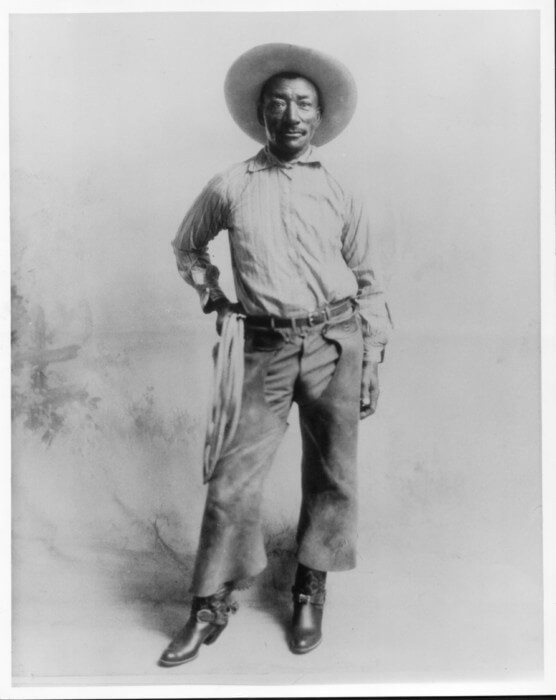Although the thought of black cowboys roping, branding cattle, and saddling up horses for rides on a ranch may seem implausible today, this lifestyle was quite common in the 1800s.
Texas was not always what it is now, although it had always been a cattle country since its colonization by Spain, according to Smithsonian Magazine. During the first half of the 19th Century, white Americans who sought cheap lands, or who tried to escape debts in the United States began migrating to the Spanish (later Mexican) territory of Texas.
They brought along their slaves even though the Mexican government was against slavery. By 1825, nearly 25% of the Texas settler population were slaves. The number rose to over 30% after fifteen years. Texas then joined the Confederacy in 1861 as a significantly new slave state.
The Civil War pulled the white owners to war, causing them to leave behind their land and cattle in the hands of their slaves. This enabled the slaves to gain the skills of cattle tending i.e. pulling calves out of mud, breaking horses, etc. that would make them indispensable to the Texas cattle industry during the period after the war.
The white Texans who left to fight in the war returned to find their herds scattered and displaced due to the fact that no security measures like fences or barbed wires had been installed to keep the herd in. The Emancipation Proclamation also left them with no workers or ‘free labor’ to help them strengthen their herds once more.
The ranchers were forced to hire and pay skilled “free” African-Americans to work as cowhands out of desperation, and start selling their livestock in northern states where beef had more value; this increased the demand for skilled black cowhands. The journeys to the northern lands were difficult because of the absence of the railroads.
Black cowboys still faced significant racism and were not allowed the opportunities their white counterparts were given, although they received respect among the crews they belonged to.
According to Black Past, the number of black cowboys began to diminish as the workers sought better-paying jobs in other industries.
Today, Oakland California continues to hold the ‘Black Cowboy Parade’ every first Saturday of October in memory of the black cowboys that helped to settle the western region of the country.
Earlier this year, a new exhibition was opened at the African American Museum in Dallas to highlight the influence of black cowboys on Texas and American history, according to Axios Dallas.
Though there is still a gap in the stories of black cowboys, there is an effort being made to preserve the little history remaining.
Highlighting the extraordinary lives of some of these historically underrated figures, here are five black famous cowboys you need to know:
Nat Love (1854 – 1921)

Nat Love was an American cowboy and writer who was born a slave on a Tennessee plantation. He was known as ‘Deadwood Dick‘ which he claims to have won as a result of his talents in roping. His autobiography, ‘The Life and Adventures of Nat Love’ which he wrote in 1907 revealed a lot about the famous cowboy.
He is known as the frontier’s most famous cowboy because of his captivating tales.
Bill Pickett (1870 – 1971)

William “Bill” Picket was an American cowboy, rodeo performer, and actor. A descendant of American Indians and black slaves in the Southwest, Picket originated rodeo steer wrestling – which is also called bulldogging.
He is popular for his works as one of the first great rodeo cowboys.
Bose Ikard (1847 – 1929)

Bose Ikard was a famous black frontiersman and trail driver in Texas. Born a slave in Noxubee County and brought to Texas at age 5, Bose later became a participant in the pioneering cattle drives. He sharpened his cowboy skills with other great ranchers in the American West, such as Charles Goodnight and Oliver Loving.
He is popularly known for joining the Goodnight-Loving Trail after the American Civil War.
Addison Jones (1845 – 1926)

Addison Jones was a black cowboy who could break horses other cowboys feared. He became a range boss for a crew of African- American cowboys working for Gorge Littlefield. Jones became a legendary cowboy throughout west Texas and eastern New Mexico for his horse-wrangling skills.
His popularity grew further when N. Howard Thorp composed and promoted a song ‘Whose Old Cow?’ that celebrated Jones’ skill for remembering and identifying more branding marks and earmarks than most cowmen were capable of.
Bass Reeves (1838 – 1910)

Bass Reeves was an American law enforcement official for 32 years and the first historically noted black deputy U.S. Marshall West of the Mississippi River. Born a slave in Crawford County, he became one of the most respected lawmen working in Indian Territory.
Reeves was a legend for the number of criminals he captured; killing 14 outlaws and arresting over 3,000, including his own son, throughout his career as an officer.










